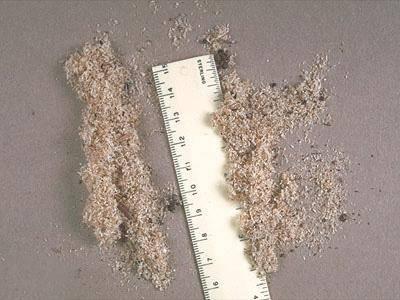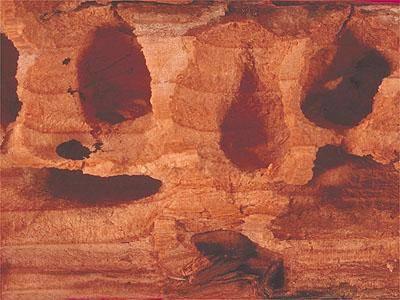About carpenter ants
-
Carpenter ants are large dark insects that can sometimes become a problem in the home. Unlike termites, they do not feed on wood but cause damage by creating nests in damp or moisture-compromised wood.
-
Once a nest is established in damp wood, galleries may be extended into sound, dry wood.
-
Tunneling may cause serious structural damage if it occurs in key timbers but nest sites rarely exceed a few square feet.
-
The existence of a carpenter ant colony inside a structure is usually most important as a sign that there is or has been a water problem.
-
The damage of wood-rotting fungi in the area of a persistent water leak or seepage can be as threatening structurally as damage caused by the ants.
-
Carpenter ants often enter homes as the weather warms in the spring and cools in the fall. If this is the only time of year that the ants are a nuisance, wait a few weeks and the problem may resolve itself without intervention.
-
Carpenter ants do not sting and can at best give a little nip with their jaws if handled.
-
They live in highly organized societies, or colonies, with a queen and hundreds or thousands of workers.
-
The 1/4 to 1/2 inch long workers are most commonly encountered by homeowners.
-
In the spring or early summer, winged queens and males may also be seen. These newly emerged reproductive forms are more conspicuous than the workers and are the largest ants in Maryland (up to 3/4 inch).
Food sources
-
Carpenter ants eat almost anything people eat and are especially fond of sweets, fats, and proteins. Other insects, dead or alive, are a major part of their diet.
-
Unlike termites, carpenter ants do not actually consume the wood of trees, stumps, or structures but they do use it for nesting.

Photo: F. E. Wood

Photo: F. E. Wood
Damage by carpenter ants
-
Carpenter ant nests consist of irregular tunnels (galleries) in which eggs are laid. The small white immatures are fed by workers until they develop into adult ants.
-
Damp or rotting wood is especially attractive for ant nests because they feed on fungal growth and the softer fibers make tunneling easier. Excavations by carpenter ants look sandpaper smooth and are kept very clean, unlike termite galleries which are packed with mud and excrement.
-
After a mating flight, the young queens search for new nest sites and shed their wings to begin new colonies.
-
Winged ants inside suggest a nest in the home.

Carpenter ants generally establish nests in decayed wood, eventually expanding galleries into sound wood
Nest location
-
Carpenter ants found inside a home may be coming from a nest (or nests) in the house or from the surrounding property.
-
Workers may travel hundreds of feet from their nest in their search for food. Ants use foliage or branches contacting the house as skywalks to increase access to the house. Entry into the house from the outside may be under doors, through holes in screens or eaves, or along service wires and pipes.
-
The presence of coarse sawdust (frass), with an appearance similar to pencil shavings, indicates that a nest is close by. This is the sawdust that the ants create and push out as they carve nest galleries.
-
With patience, one can follow worker ants to locate the nest. Carpenter ants are most active after dark. This is frequently the easiest time to locate nests.
Common carpenter ant nesting sites
In or outside the home
Damp areas where rainwater comes in or where plumbing leaks or seepage occur:
-
Window and door sills
-
Behind downspouts
-
In walls where gutters overflow
-
Under shingles
-
Below a leak in a roof valley
-
Under dishwashers and washing machines
-
Under shower or tub drains
-
Bathroom or kitchen wall voids
-
Behind water damaged fascia
-
Under chimney flashing
-
In firewood recently brought into the home
-
Near air-conditioning condensation
-
In insulation
-
In wood in direct contact with soil
Outside
-
Firewood, stumps, trees. Carpenter ant activity in a tree is often a secondary issue and can be a sign that the tree has wood rot.
-
Untreated landscape timbers, decks, porch steps, and pillars
-
Structural modification
-
Discourage ants by replacing moist or rotting wood with pressure treated or borate treated wood.
-
Trim shrub and tree limbs to prevent contact with the house.
-
Caulk areas where wires and pipes enter the house, as well as cracks around window and door frames.
-
Keep gutters clean to promote proper drainage.
-
Modify the grade along the house so that water drains away from the foundation.
-
Store firewood in a dry location away from the house.
-
Ventilate attics and crawl spaces to reduce humidity.
Management
-
Repairing structural problems is the most effective preventive and protective measure against carpenter ants.
-
The best control mechanism for severe infestations is to locate the nest and, if accessible, have a pest control professional apply pesticide directly to the colony headquarters.
-
Granular baits designed specifically for carpenter ants are also available to pest controllers if the nest cannot be located.
-
Homeowners have the option of using containerized ant bait in small, sealed plastic trays. These baits are available through pest control operators or from a variety of retail stores. If the ants accept the bait the colony can be killed within several days.
-
Individual ants can be removed by vacuuming.
-
Indoor spraying is not recommended. At best only a few ants are killed and sprays can compromise the effectiveness of baits. In addition, occupants are needlessly exposed to potentially toxic chemicals. Residual sprays around the outside perimeter of the house are not recommended. At best, they provide only temporary relief and are useless if the nest is inside.
Based on publication HG 115 Carpenter Ants, Authors: Nancy L. Breisch (retired) and Barbara L. Thorne (retired) Department of Entomology, University of Maryland, Maryland Extension
Revised: Mary Kay Malinoski, University of Maryland Extension Specialist (retired). 2020
